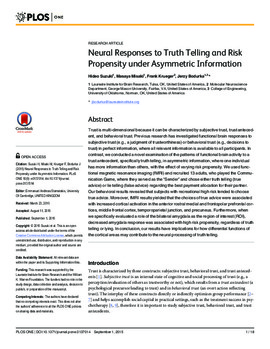| dc.contributor.author | Hideo Suzuki | |
| dc.contributor.author | Masaya Misaki | |
| dc.contributor.author | Frank Krueger | |
| dc.contributor.author | Jerzy Bodurka | |
| dc.date.accessioned | 2017-03-05T22:55:10Z | |
| dc.date.available | 2017-03-05T22:55:10Z | |
| dc.date.issued | 2015-09-01 | |
| dc.identifier.citation | Suzuki H, Misaki M, Krueger F, Bodurka J (2015) Neural Responses to Truth Telling and Risk Propensity under Asymmetric Information. PLoS ONE 10(9): e0137014. doi:10.1371/journal.pone.0137014 | en_US |
| dc.identifier.uri | https://hdl.handle.net/11244/49271 | |
| dc.description | This research was supported by the Laureate Institute for Brain Research and the William K. Warren Foundation. The funders had no role in the study design, data collection and analysis, decision to publish, or preparation of the manuscript. | en_US |
| dc.description | | en_US |
| dc.description.abstract | Trust is multi-dimensional because it can be characterized by subjective trust, trust antecedent, and behavioral trust. Previous research has investigated functional brain responses to subjective trust (e.g., a judgment of trustworthiness) or behavioral trust (e.g., decisions to trust) in perfect information, where all relevant information is available to all participants. In contrast, we conducted a novel examination of the patterns of functional brain activity to a trust antecedent, specifically truth telling, in asymmetric information, where one individual has more information than others, with the effect of varying risk propensity. We used functional magnetic resonance imaging (fMRI) and recruited 13 adults, who played the Communication Game, where they served as the “Sender” and chose either truth telling (true advice) or lie telling (false advice) regarding the best payment allocation for their partner. Our behavioral results revealed that subjects with recreational high risk tended to choose true advice. Moreover, fMRI results yielded that the choices of true advice were associated with increased cortical activation in the anterior rostral medial and frontopolar prefrontal cortices, middle frontal cortex, temporoparietal junction, and precuneus. Furthermore, when we specifically evaluated a role of the bilateral amygdala as the region of interest (ROI), decreased amygdala response was associated with high risk propensity, regardless of truth telling or lying. In conclusion, our results have implications for how differential functions of the cortical areas may contribute to the neural processing of truth telling. | en_US |
| dc.language.iso | en_US | en_US |
| dc.publisher | PLos One | |
| dc.relation.ispartofseries | PLoS ONE 10(9): e0137014 | |
| dc.relation.uri | http://www.plosone.org/article/info%3Adoi%2F10.1371%2Fjournal.pone.0137014 | |
| dc.rights | Attribution 3.0 United States | |
| dc.rights.uri | https://creativecommons.org/licenses/by/3.0/us/ | |
| dc.subject | Amygdala,Asymmetric information,Decision making,Functional magnetic resonance imaging,Prefrontal cortex,Frontal lobe,Games,Behavior | en_US |
| dc.title | Neural Responses to Truth Telling and Risk Propensity under Asymmetric Information | en_US |
| dc.type | Research Article | en_US |
| dc.description.peerreview | Yes | en_US |
| dc.description.peerreviewnotes | http://www.plosone.org/static/editorial#peer | en_US |
| dc.identifier.doi | 10.1371/journal.pone.0137014 | en_US |
| dc.rights.requestable | false | en_US |

